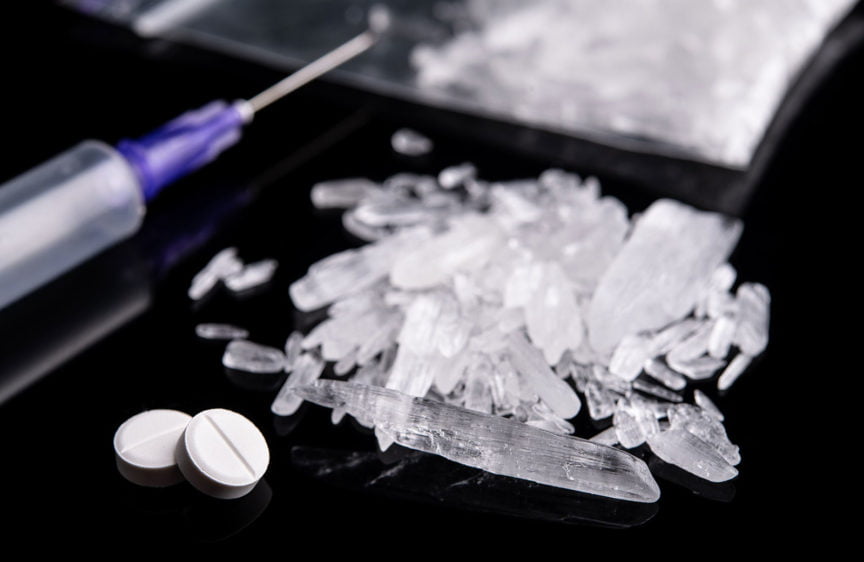Paramedics roll in with an agitated young man, “John”. He is combative, rambling, sweaty and scared. The crew mention they found needles and a bag containing a crystalline white substance in his pockets: methamphetamine. Right away, you start thinking about your initial approach to a patient with excited delirium.
In the room, four security guards are needed to restrain him. On inspection, you observe no signs of head trauma, and symmetrical movement of his extremities and face. You note his pupils are dilated (7mm bilaterally), and that sweat is pouring off his face. You defer the remainder of your exam for the moment and instruct your team to administer midazolam 10 mg IM immediately.
Why is Methamphetamine Important?
Methamphetamine is currently the second-most popular illicit drug in the world.
Its use is associated with short-term and long-term harms to both individuals and communities. Life-threatening acute toxicity will be discussed here, but chronic use of methamphetamine is associated with psychosis, addiction, and medical issues (for example, endocarditis from IV drug use).1
Methamphetamine Pharmacokinetics
| Mode of Use (aka route of exposure) | Time to Peak Effect | Half-Life |
| Intravenous | < 15 minutes | 10-34 hours; |
| Inhalational (smoking) | ~20 minutes | acute effects last~8 hours |
| Intranasal | < 15 minutes | acute effects last~8 hours |
| Oral | ~ 180 minutes | acute effects last~8 hours |
Methamphetamine Physiology and Pharmacodynamics
Methamphetamine stimulates the release of norepinephrine, dopamine and serotonin and inhibits their degradation, leading to further accumulation. The clinical effects are as follows:1,3
| Neurotransmitter | Clinical Effects of Increased Neurotransmitter Concentration |
| Dopamine | Euphoria, stimulation of reward pathway, contributing to addiction |
| Noradrenaline | Alertness, tachycardia, hypertension, vasoconstriction, inotropy |
| Serotonin | Euphoria, illusionic effects |
Case Continues:
10 minutes later, John continues to require physical restraints. The nurse has placed 2 large-bore IVs, sent off bloodwork and completed a set of vital signs:
Tympanic temperature 39.1 C, HR 150 BPM, BP 190/100 mmHg, RR 40 breaths/minute, SpO2 98% on room air. A capillary blood glucose is 5.0 mmol/L
You order more sedation. You also order cooled IV fluids, ice packs in his axillae + groin, and ask for help spraying cool mist to be evaporated by fans.
Clinical Presentations of Acute Methamphetamine Toxicity
The majority of patients presenting to the ED with methamphetamine toxicity have behavioural disturbances and are acutely agitated. These patients often have many features of the sympathomimetic toxidrome including tachycardia, hypertension, diaphoresis, and mydriasis. If no life-threatening complications are present, the acutely agitated patient responds well to sedation.
| Organ System | Symptoms and signs | Complications |
| Neurologic | Delirium, tremors, mydriasis, seizures, focal neurologic deficits (due to intracranial hemorrhage) | Hyperthermia, seizures, coma |
| Psychiatric | Hallucinations, anxiety, paranoia, psychosis, repetitive skin picking | Psychosis |
| Cardiovascular | Palpitations, chest pain | ACS, dysrhythmias, dilated cardiomyopathy*, heart failure, aortic dissection, endocarditis |
| Respiratory | Dyspnea | ARDS, aspiration pneumonia |
| Abdominal | Nausea, vomiting, diarrhea, diffuse abdominal pain | Ischemic colitis |
| Renal | Acute kidney injury | |
| Skin | Excoriations and ulcers, diaphoresis | Cellulitis, osteomyelitis, bacteremia |
| Musculoskeletal | Myalgias | Rhabdomyolysis |
What is the Differential Diagnosis for a “Hot and Bothered” Patient?
| Etiology/System | Disease | Some Distinguishing Features | Useful tests or diagnostic considerations |
| Toxicologic | Anticholinergic toxicity | Dry axilla, urinary retention (anticholinergic toxidrome) | |
| Acetylsalicylic acid (ASA) toxicity | Tachypnea | ASA level | |
| Cocaine toxicity | Short duration and usually not profoundly altered | ECG | |
| PCP toxicity | Short duration; nystagmus | ||
| Iatrogenic | Serotonin syndrome | History of exposure to serotonergic drugs, hyperreflexia, clonus | Hunter criteria |
| Neuroleptic malignant syndrome | History of exposure to antipsychotic drugs; “lead pipe” rigidity | CK can be elevated | |
| Withdrawal | Benzodiazepine withdrawal | History of regular use with sudden cessation | |
| Alcohol withdrawal | History of regular use with sudden cessation | ||
| Neurologic | CNS infections | Nuchal rigidity in meningitis | Neuroimaging, lumbar puncture, blood culture |
| Seizure disorder +/- post-ictal | History of seizure | Electrolytes, glucose. | |
| Intracranial hemorrhage | Hyperthermia more rare; focal neurological deficits present | Neuroimaging | |
| Environmental | Heat stroke | History of exposure | |
| Endocrine | Thyrotoxicosis | History/physical to suggest other thyrotoxic findings (goiter, proptosis, etc.) | TSH +/- free T3, T4 |
| Pheochromocytoma | History of paroxysmal spells, including headaches, tachycardia, diaphoresis | Urine and plasma metanephrine and catecholamine levels (NOT done in emergency department) | |
| Hypoglycemia | Hyperthermia not common unless co-existing infection | POCT glucose | |
| Trauma | Head trauma | Clinical presentation in keeping with trauma | Neuroimaging |
| Vascular | Thalamic stroke | Focal deficits; not agitated | Neuroimaging |
| Autoimmune | Encephalitis | Onset usually not acute | Neuroimaging, lumbar puncture |
Testing and Diagnosis of Methamphetamine Toxicity
In the ED methamphetamine toxicity is generally a clinical diagnosis. In patients with life-threatening presentations, it is appropriate to order an ECG, blood work (including electrolytes, renal function, liver enzymes, troponin, and a CK). One can consider a urine for myoglobin, imaging, and other investigations to address potential other causes.5
The presence of amphetamine and methamphetamine in urine can be determined by immunoassays and/or mass spectrometry-based assays, but it’s rarely needed or useful in the acute setting.
Case Continues:
At the bedside, John is non-sensical, and aggressive. His HR is 160, and a repeat temperature is now 41.5C, despite having removed his clothes, the cooled IV fluids, ice packs and misting. You give him another 10 mg of midazolam IV but have serious concerns about his hyperthermia and agitation.
Management of Methamphetamine Toxicity
The guiding principle of management in the patient with methamphetamine toxicity and hyperthermia is aggressive supportive care.
Agitation
Benzodiazepines are 1st-line therapy and generally the safest option for agitation in any toxicologic presentation, which is useful in these patients that often have multiple substances involved. Lorazepam, diazepam or midazolam are all readily accessible in most emergency departments. Antipsychotics are 2nd-line management, and a useful adjunct to benzodiazepines. Ketamine is also a useful medication and given intramuscularly at 2-4mg/kg is an effective and safe sedative.5–7
If patients are too agitated or behaving violently, administration of sedation can be a safety risk to staff. In these, security personnel and physical restraints are often required temporarily. Restraints should be removed as soon as it is safe to do so, as they are associated with higher mortality and morbidity.
Hyperthermia
Aggressive management is important, as mortality is directly related to duration and degree of temperature elevation. A good strategy is to attempt to cool a hyperthermic patient to a core temperature under 38°C as quickly as possible.5
First, remove clothing and optimize the environment to be as cool as possible.
Second, provide sedation to reduce agitation and the resulting heat production driven by muscle use.5,7
Third, employ active cooling techniques. Initial active cooling techniques include both evaporative and conductive methods: ice packs in the axillae and groins and cooling blankets (conductive), spraying cool water over the body while using fans to blow it off (evaporative).8
More aggressive conductive techniques include cold water immersion (CWI). If you are in an ED capable of submerging a patient in an ice bath, do so. Alternatives to the CWI method are the tarp-associated cooling oscillation (TACO) technique, which involves placing a patient in a body bag filled with cooled fluids.8,9 Cooled IV fluids (~4°C) are also effective (each liter cools by about 1C when patient temperature is around 40°C).8,10
Finally, if the above techniques are not effective, or if needed to facilitate care – the patient should be paralyzed and intubated.5
Airway Management
Indications for definitive airway control in the patient with methamphetamine toxicity include:
- Sufficiently altered mental status with clinical trajectory showing inadequate return to alertness
- Hyperthermia requiring paralysis
- Other specific clinical indications (aspiration with hypoxia, dysrhythmias with hemodynamic instability, etc.)
- Facilitation of further investigations (bloodwork, CT-head, lumbar puncture)
Rapid sequence intubation is a good approach for intubating the methamphetamine toxic patient. Important considerations include their hemodynamics and the potential for rhabdomyolysis.
Case Continues:
John’s clinical course necessitates intubation for several reasons:
- His hyperthermia is life-threatening, he is unable to cooperate with conservative measures like ice packs and they are not working effectively in cooling him.
- He is driving worsening rhabdomyolysis and is been refractory to sedation strategies.
- He is at risk of circulatory collapse from insensible losses, exposure to methamphetamine, fluid deprivation, tachycardia and hypertension.
- He requires further investigations.
| Symptom | Management |
| Airway management | See discussion above for indications Consider using rocuronium over succinylcholine given risk of hyperkalemia secondary to rhabdomyolysis |
| Agitation | Co-operative patient: PO: Lorazepam 1-4mg Diazepam 5-10mg Un-cooperative patient: IM: Midazolam 5-10mg or Lorazepam 1-2mg IV: Diazepam 5-10mg or Midazolam 2.5-5mg +/- Antipsychotic: Olanzapine or haloperidol +/- IM Ketamine |
| Hyperthermia | Remove clothing Ice submersion bath OR Ice packs in groin, axilla OR Tarp-associated cooling oscillation (TACO) Spray with cool water, Fans Cooled IV fluid Muscle relaxants (benzodiazepines) Paralysis, intubation |
| Seizure | Benzodiazepines: (see section on agitation) |
| Cardiac dysrythmias | Benzodiazepines Lidocaine |
| Hypertension | Benzodiazepines Phentolamine Nitroprusside |
| Rhabdomyolysis | IV fluids Benzodiazepines |
Case Conclusion
John is intubated using an RSI and started on a propofol infusion. He is still receiving cooled IV fluids and being sprayed with water with a fan to blow on him.
An esophageal thermometer is placed to give a reliable core temperature reading, which is still 41.0°C. You and your team put together a TACO assembly.
About 25 minutes later, the esophageal temperature probe reads 38.7 C, showing a response to the cooling strategies. You arrange for a CT-head in the next hour or so, repeat the bloodwork. Next, you call your colleagues in the ICU, who readily meet you at the bedside and assume care of the patient.
[bg_faq_start]More From This Toxicology Series
Hydroxychloroquine and Chloroquine Toxicity
[bg_faq_end]This post was copyedited by Rhiannan Pinnell (@PinnellRhiannan) and was edited by Daniel Ting (@tingdan).
References
- 1.Paulus M, Stewart J. Neurobiology, Clinical Presentation, and Treatment of Methamphetamine Use Disorder: A Review. JAMA Psychiatry. 2020;77(9):959-966. doi:10.1001/jamapsychiatry.2020.0246
- 2.Cruickshank C, Dyer K. A review of the clinical pharmacology of methamphetamine. Addiction. 2009;104(7):1085-1099. doi:10.1111/j.1360-0443.2009.02564.x
- 3.Kish S. Pharmacologic mechanisms of crystal meth. CMAJ. 2008;178(13):1679-1682. doi:10.1503/cmaj.071675
- 4.Richards J, Laurin E. statpearls. Published online August 11, 2021. http://www.ncbi.nlm.nih.gov/books/NBK430895/
- 5.Halloran L, Bernard D. Management of drug-induced hyperthermia. Curr Opin Pediatr. 2004;16(2):211-215. doi:10.1097/00008480-200404000-00018
- 6.Wodarz N, Krampe-Scheidler A, Christ M, et al. Evidence-Based Guidelines for the Pharmacological Management of Acute Methamphetamine-Related Disorders and Toxicity. Pharmacopsychiatry. 2017;50(3):87-95. doi:10.1055/s-0042-123752
- 7.Barbic D, Andolfatto G, Grunau B, et al. Rapid Agitation Control With Ketamine in the Emergency Department: A Blinded, Randomized Controlled Trial. Ann Emerg Med. 2021;78(6):788-795. doi:10.1016/j.annemergmed.2021.05.023
- 8.Wasserman D, Creech J, Healy M. statpearls. Published online August 14, 2021. http://www.ncbi.nlm.nih.gov/books/NBK459311/
- 9.Luhring K, Butts C, Smith C, et al. Cooling Effectiveness of a Modified Cold-Water Immersion Method After Exercise-Induced Hyperthermia. J Athl Train. 2016;51(11):946-951. doi:10.4085/1062-6050-51.12.07
- 10.Parker K, Shelton R, Lopez R. Do Alternative Cooling Methods Have Effective Cooling Rates for Hyperthermia Compared With Previously Established CWI Cooling Rates? J Sport Rehabil. 2020;29(3):367-372. doi:10.1123/jsr.2019-0098
Reviewing with the Staff
Methamphetamine use is an issue in our communities, and there are many reasons why people who use methamphetamine present to the emergency department. The agitated, hyperthermic patient is one of the most concerning presentations, and an efficient, informed approach to resuscitating someone with this presentation is crucial.




